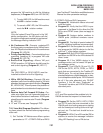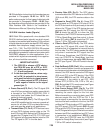
INSTALLATION-PERIPHERALS
SECTION 100-816-207
MARCH 1993
7-35
10.13 Installation instructions for these devices are
provided in Paragraphs 10.40 thru 10.70. Call
paths and scenarios for five types of data test calls
are provided in Paragraphs 10.82 ~ 10.86. Step-
by-step data calling procedures are provided in the
Data Interface User Guide
in the
Installation &
Maintenance Manual
,
Operating Procedures.
10.20 EIA Interface Leads (Signals)
10.21 Both DIUs operate with nine standard EIA
RS-232 interface leads (signals) on which signal-
ing data is transmitted and received. DIUs connect
to serial data devices with standard RS-232 cables,
available from telephone supply stores (see Fig-
ures 7-25 ~ 7-30). The PDIU-DI/PDIU-DS requires
nine signals for some applications, but can function
with eight using modular cords and connectors with
RJ45/DB25 adapters for other applications. If un-
certain which signals are necessary for an applica-
tion, all nine should be connected.
IMPORTANT NOTES!
1. The PDIU-DI is always a DCE device;
the PDIU-DS may be a DTE or DCE,
depending on how its internal jumpers
(1 ~ 9) are configured.
2. In the descriptions below, when a sig-
nal is ON, its potential is about seven
volts positive relative to signal ground
(pin 7); when a signal is OFF, it is about
7 volts negative relative to the signal
ground (pin 7).
Frame Ground (FG, Pin 1): The FG signal (EIA
circuit AA) is a protective or safety ground which
is bonded to the PDIU-DI/PDIU-DS PCB. If
required by local codes, the FG should be con-
nected to external ground.
Signal Ground (SG, Pin 7): The SG signal (EIA
circuit AB) establishes the common ground ref-
erence for all other PDIU and data device sig-
nals and must be wired for all applications.
Transmit Data (TD, Pin 2): DTE devices trans-
mit and DCE devices receive data on the TD
lead (EIA circuit BA). Before the DTE device can
transmit the TD signal, the RTS, CTS, DSR, and
DTR signals (all discussed below) must be ON.
The TD signal is OFF in the idle state.
Receive Data (RD, Pin 3): The DCE device
transmits data to the DTE device on the RD lead
(EIA circuit BB); the DTE receives data on the
RD.
Request to Send (RTS, Pin 4): Some DTE
devices send an RTS signal (EIA circuit CA) to
the DCE device when they are ready to transmit
data on the TD lead. If the DTE device does not
generate the RTS signal, the DIU DIP switch
SW1-4 should be set ON to inform the DIU.
Sometimes, the DTE/DCE device may use RTS/
CTS for Ready/Busy type flow control, in these
cases DIP switch SW1-4 should be OFF (see
Figure 7-32 for DIP switch information).
Clear to Send (CTS, Pin 5): The DCE device
sends the CTS signal (EIA circuit CB) which
indicates that it is prepared to transmit data to
the line side. The DCE device sends this signal
only when it receives the RTS signal from the
DTE device. Sometimes, the DTE/DCE device
may use RTS/CTS for Ready/Busy type flow
control; in these cases, dip switch SW1-4 should
be OFF (see Figure 7-32 for DIP switch informa-
tion).
Data Set Ready (DSR, Pin 6): When connected
to the communication channel and prepared to
exchange control characters to initiate data trans-
mission, the DCE device sends the DSR signal
(EIA circuit CC) to the DTE device. If the PDIU
DIP switch SW1-2 is set ON, DSR will be ON
continuously; if the switch is set OFF, DSR
follows DTR (if DSR is ON, DTR is ON, etc.)
SW1-2 should be OFF in most cases (see Figure
7-32 for DIP switch information).
Data Carrier Detect (DCD, Pin 8): The DCE
device sends the DCD signal (DCD, Pin 8) when
receiving the carrier signal on the line side.
Before transmitting or receiving data, most DTE
devices require that the DCD be ON. If the
carrier signal is removed by the remote end or
lost due to a fault condition on the line, the DCE
notifies the DTE device by an OFF condition with
the DCD signal; PDIU DIP switch SW1-2 is set
ON to set the DCD ON continuously; if set OFF,
the DCD signal will only be ON when connection
between two DIUs is established and OFF when
a connection is not established. SW1-2 is set
OFF when the DTE/DCE uses the DTR/DSR
signals for Ready/Busy flow control (see Figure
7-32 for DIP switch information).


















